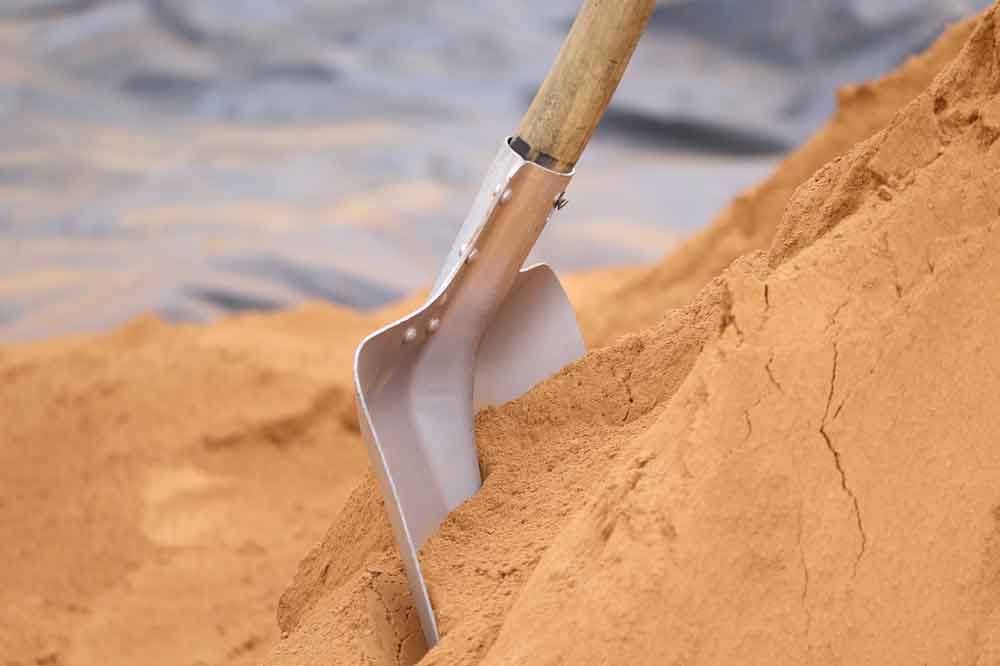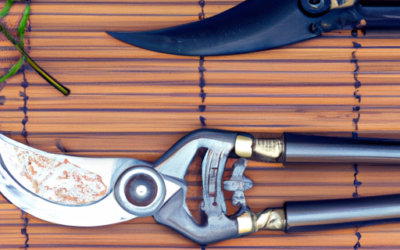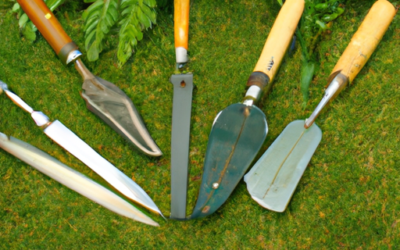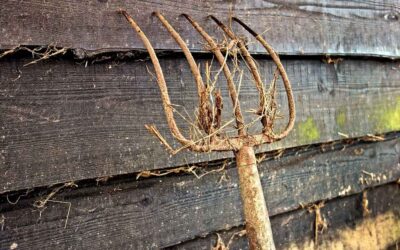If you’re a gardening enthusiast looking to add a touch of Japanese elegance to your outdoor space, then this guide is for you. In “Japanese garden spades: A Comprehensive Buying Guide,” we’ll take you through everything you need to know before purchasing the perfect spade for your Japanese-inspired garden. From the different types and designs available to the materials used, we’ve got you covered. Get ready to make your gardening experience even more enjoyable with the right Japanese garden spade.
Key Features to Consider
When choosing a Japanese garden spade, there are several key features to consider that will greatly impact your gardening experience. These features include blade material, blade shape, handle material, handle length, weight, grip comfort, durability, versatility, and price range. By evaluating these factors, you can find the perfect Japanese garden spade that suits your needs and preferences.
Blade Material
The blade material of a Japanese garden spade is an important factor to consider as it determines the tool’s overall durability and performance. Two common blade materials used in Japanese garden spades are carbon steel and Stainless Steel.
-
Carbon Steel: Known for its exceptional sharpness and strength, carbon steel blades are a popular choice among gardeners. They are highly resistant to dulling and can easily cut through roots and tough soil. However, it is important to note that carbon steel blades are susceptible to rust and require regular maintenance to prevent corrosion.
-
Stainless Steel: If you’re looking for a low-maintenance option, stainless steel blades are a great choice. They offer excellent resistance to rust and corrosion, making them ideal for gardeners who prefer minimal upkeep. While stainless steel blades may not be as sharp as carbon steel blades, they still provide efficient cutting power and durability.
Blade Shape
The blade shape of a Japanese garden spade impacts its functionality and versatility. Here are four common blade shapes you will come across:
-
Pointed: A pointed blade is ideal for precision work such as transplanting seedlings and digging small holes. It allows for accurate and controlled movements, making it a popular choice for delicate gardening tasks.
-
Serrated: A serrated blade is designed with jagged teeth along the edge, making it suitable for cutting through tough roots and dense vegetation. It offers enhanced cutting power and can be particularly useful when tackling overgrown areas.
-
Curved: A curved blade is designed to mimic the shape of your hand, allowing for more natural, ergonomic movements. It provides better leverage when digging, and the curved shape helps prevent soil from falling off the blade during use.
-
Rectangular: A rectangular blade offers a larger surface area, making it effective for tasks that require moving larger quantities of soil. It provides stability and control, allowing you to easily scoop and transfer soil or other materials.
Handle Material
The handle material of a Japanese garden spade greatly impacts its comfort, durability, and overall feel. Here are three common handle materials to consider:
-
Wood: Wooden handles offer a traditional and natural look and feel. They provide excellent grip and insulation from temperature extremes, making them comfortable to use in any weather condition. However, wood handles require regular maintenance to prevent cracking or splintering.
-
Metal: Metal handles, typically made of aluminum or steel, offer exceptional durability and strength. They are resistant to weathering and can withstand heavy-duty usage. Metal handles can be heavier than other materials, so it’s important to consider the weight and balance of the spade when choosing this option.
-
Plastic: Plastic handles are lightweight and often more affordable than other materials. They require minimal maintenance and are resistant to moisture and damage. However, they may not provide the same level of comfort and longevity as wood or metal handles.
Handle Length
The handle length of a Japanese garden spade plays a crucial role in the tool’s maneuverability and comfort. Here are four common handle lengths to choose from:
-
Short (6-10 inches): Short-handled garden spades are ideal for working in tight spaces or for gardeners who prefer closer control over their movements. They are particularly useful for tasks that require kneeling or crouching.
-
Standard (10-15 inches): Standard handle lengths offer a balanced compromise between control and reach. They provide sufficient leverage for most gardening tasks and are comfortable for the average-sized gardener.
-
Long (15-20 inches): Long-handled garden spades are beneficial for gardeners who prefer to work in an upright position, minimizing strain on the back and knees. They provide extended reach and leverage, making them ideal for larger garden areas.
-
Extra Long (20+ inches): Extra long-handle garden spades offer maximum reach and are generally utilized for specialized tasks or for gardeners who require extended reach due to physical limitations.
Weight
The weight of a Japanese garden spade greatly affects its maneuverability, ease of use, and overall comfort. Here are three weight categories to consider:
-
Lightweight (less than 1 lb): Lightweight garden spades are easy to carry and maneuver, making them ideal for intricate gardening tasks that require precision and control. They are particularly useful for gardeners with limited strength or mobility.
-
Medium Weight (1-2 lbs): Medium-weight garden spades strike a balance between maneuverability and durability. They provide enough heft to tackle heavier soil or vegetation while remaining comfortable to use for extended periods.
-
Heavyweight (2+ lbs): Heavyweight garden spades offer superior strength and durability, making them suitable for demanding gardening tasks. However, they can be more challenging to handle, especially for gardeners with limited strength or mobility.
Grip Comfort
The grip comfort of a Japanese garden spade is essential to ensure a comfortable and secure grip during use. Here are three grip features to consider:
-
Ergonomic Design: Ergonomically designed garden spades are shaped to fit the contours of your hand, reducing strain and fatigue. They provide a more relaxed grip and allow for natural movements, reducing the risk of hand and wrist injuries.
-
Non-Slip Handle: A non-slip handle is essential for maintaining a secure grip, even when your hands are wet or covered in soil. Look for spades with textured or rubberized handles that provide enhanced grip and prevent accidental slipping.
-
Cushioned Grip: A garden spade with a cushioned grip offers extra comfort during prolonged use. The padding absorbs vibrations and reduces strain on your hands and wrists, allowing you to work for longer periods without discomfort.
Durability
When investing in a Japanese garden spade, durability is a crucial factor to consider to ensure it withstands rigorous gardening tasks and lasts for years to come. Here are three durability factors to assess:
-
Rust Resistance: Look for garden spades with blades that are treated or coated to resist rust. This is particularly important if you opt for carbon steel blades, as they are more susceptible to rusting. Stainless steel blades, on the other hand, naturally offer better rust resistance.
-
Corrosion Resistance: In addition to rust resistance, corrosion resistance is essential, especially if you live in an area with high humidity or experience exposure to saltwater. Stainless steel blades excel in corrosion resistance, making them a reliable choice for longevity.
-
Solid Construction: Pay attention to the overall construction of the garden spade, ensuring that it is robust and well-built. Check for any loose components, wobbling, or signs of weak points that may compromise the spade’s durability over time.
Versatility
The versatility of a Japanese garden spade allows it to be used for a wide range of gardening tasks, from digging and transplanting to weeding and cultivating. Look for features such as interchangeable blades or multiple blade shapes that enable the spade to adapt to various gardening needs. A versatile garden spade can save you money and storage space by replacing multiple specialized tools.
Price Range
The price range for Japanese garden spades can vary greatly, depending on the materials used, brand reputation, and additional features. Here are three price ranges to consider:
-
Budget Options: Budget-friendly garden spades can be found at a lower price point without compromising essential functionalities. They are great for occasional gardeners or those looking to try out Japanese garden spades without a significant financial commitment.
-
Mid-Range Options: Mid-range garden spades offer a good balance between affordability and quality. They often provide improved durability, comfort, and functionality compared to budget options. These are suitable for gardeners with moderate needs and expectations.
-
High-End Options: High-end garden spades are renowned for their exceptional quality, durability, and advanced features. They are designed for professional gardeners or avid enthusiasts who prioritize longevity and performance. Investing in a high-end garden spade ensures superior craftsmanship and functionality.
In conclusion, selecting the right Japanese garden spade requires careful consideration of various key features. By evaluating blade material, blade shape, handle material, handle length, weight, grip comfort, durability, versatility, and price range, you can find a garden spade that meets your specific gardening needs and preferences. Whether you are a seasoned gardener or just starting, a well-chosen Japanese garden spade will greatly enhance your gardening experience and help you create beautiful outdoor spaces.








